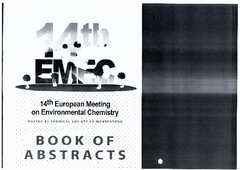| dc.creator | Lazić, S. | |
| dc.creator | Šunjka, D. | |
| dc.creator | Milovanović, I | |
| dc.creator | Grahovac, Nada | |
| dc.date.accessioned | 2023-08-17T08:11:25Z | |
| dc.date.available | 2023-08-17T08:11:25Z | |
| dc.date.issued | 2013 | |
| dc.identifier.uri | http://fiver.ifvcns.rs/handle/123456789/3724 | |
| dc.description.abstract | Non-point-source contamination of surface water has emerged as an important environmental problem during the last decades. This is particularly obvious in areas with intensive pesticide application. Considering importance of water and soil quality, pesticide residues in our environment need to be more effectively documented. This study has focused on determination of pesticide residues in drainage water. Monitoring of pesticide residues were conducted at different locations in the northern part of Serbia, the main agricultural area of the country. The sampling was performed during spring and summer 2012 on twelve potential risk sites. The extraction of pesticides from water was carried out with ENVI™ C18 DSK 47 mm (Supelco 5-7171, Bellafonte, PA). Prior to extraction disc was conditioned with 5 ml of methanol and 5 ml of ultrapure water. Afterward, water sample was filtered through the disc under vacuum and disc was dried for 1 h at 25 °C. Pesticides were eluted from the disc with 5 ml of mixture dichloromethane/n-hexane (40/60, v/v) and evaporated to dryness. The extract was reconstituted in 1 ml of methanol, ultrasonically homogenized and analyzed. Analyses were performed on Agilent Technologies GC-MS Model 7890 A Series gas chromatograph coupled to 5975 C mass selective detector. A HP5MS (30 mx 0.25 mmi.d.) fused silica capillary column was used. Helium was used as the carrier gas at a constant pressure. Injection volume was 2.0 ul, in splitless mode at 280 °C. The total run time was 41.86 min. The interface was kept at 250 °C, the quadropole at 150 °C and the mass spectra were obtained at electron energy of 70 eV. After validation and measurement uncertainty evaluation steps, results obtained showed that the method can be applied to efficiently for monitoring of pesticide residues in water samples. In analyzed samples 22 pesticides were detected -8fungicides,9 herbicides and 5 insecticides. Herbicides were most frequently detected (in 41% of the samples), followed by fungicides (36%) and insecticides (23%) | sr |
| dc.language.iso | en | sr |
| dc.relation | info:eu-repo/grantAgreement/MESTD/Integrated and Interdisciplinary Research (IIR or III)/43005/RS// | sr |
| dc.rights | openAccess | sr |
| dc.rights.uri | https://creativecommons.org/licenses/by/4.0/ | |
| dc.source | 14th European Meeting on Enviromental Chemistry, Budva, 4 December 2013 | sr |
| dc.subject | pesticides | sr |
| dc.subject | residues | sr |
| dc.subject | surface water | sr |
| dc.subject | canal water | sr |
| dc.title | Screening of pesticide residues in canal water in the Northern Serbia | sr |
| dc.type | conferenceObject | sr |
| dc.rights.license | BY | sr |
| dc.citation.epage | 134 | |
| dc.citation.spage | 134 | |
| dc.identifier.fulltext | http://fiver.ifvcns.rs/bitstream/id/9224/bitstream_9224.pdf | |
| dc.identifier.rcub | https://hdl.handle.net/21.15107/rcub_fiver_3724 | |
| dc.type.version | publishedVersion | sr |


